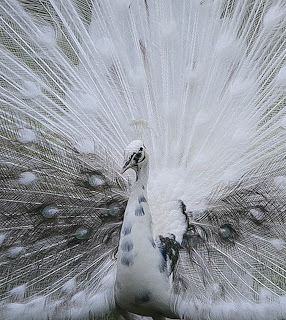A lot of time has passed since my last post and I now have some new photos that I think you'll like. Surprisingly, I very luckily came across an opportunity to photograph a white peacock, located at a property where several other peacocks strolled around the yard.
According to Wikipedia, “Leucistic peafowl can produce pigment but not deposit the pigment to their feathers, resulting in their blue-grey eye color and the complete lack of coloration in their plumage. Leucism is only partial loss of pigment in various amounts and is an issue at the pigment cellular level."
"The Whooping Crane is the tallest North American bird, named for its whooping sound. It is an endangered crane species. Along with the sandhill crane, it is one of only two crane species native to North America. The whooping crane's lifespan is estimated to be 22 to 24 years in the wild." Wikipedia. The following photos were taken at the Horicon Marsh near Waupun, Wisconsin:
Whoopers often sound off with a bugling type of song when they call to one another or when they want to warn other birds like Sandhills to keep out of their territory.
Red Wing Blackbirds frequently attack large birds that get too close to their nests or simply invade their territory, and they are not intimidated by the very large whoopers.
These photos are of the young "colt" recently born to this nesting pair. Not sure why they are called "colt" but young sandhill cranes are also called "colts."
Sandhill Cranes
Cormorant with lunch.
This is an enhanced photo of White Pelicans.
They often hunt in groups like those above.
Below is a trumpeter swan, barely awake.
More trumpeters.
Do you have any idea how long it took me to strategically place those droplets?
Two beautiful Great Egrets
This is what greets me when I arrive at the marsh at daybreak!
Stay safe, everyone!








.jpg)

_pe.jpg)


_pe.jpg)

_pe.jpg)




_pe.jpg)
_pe.jpg)
_pe.jpg)
No comments:
Post a Comment